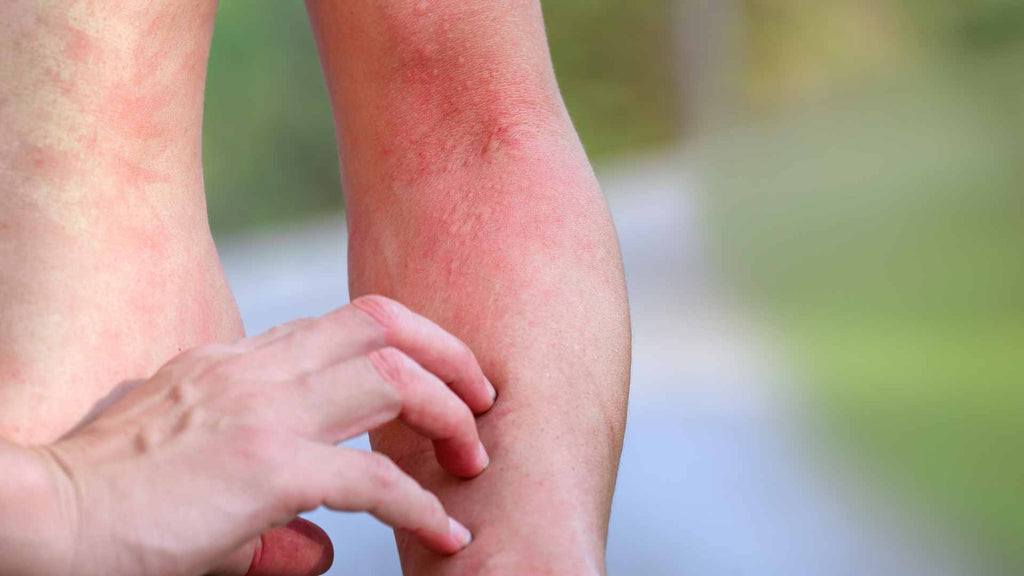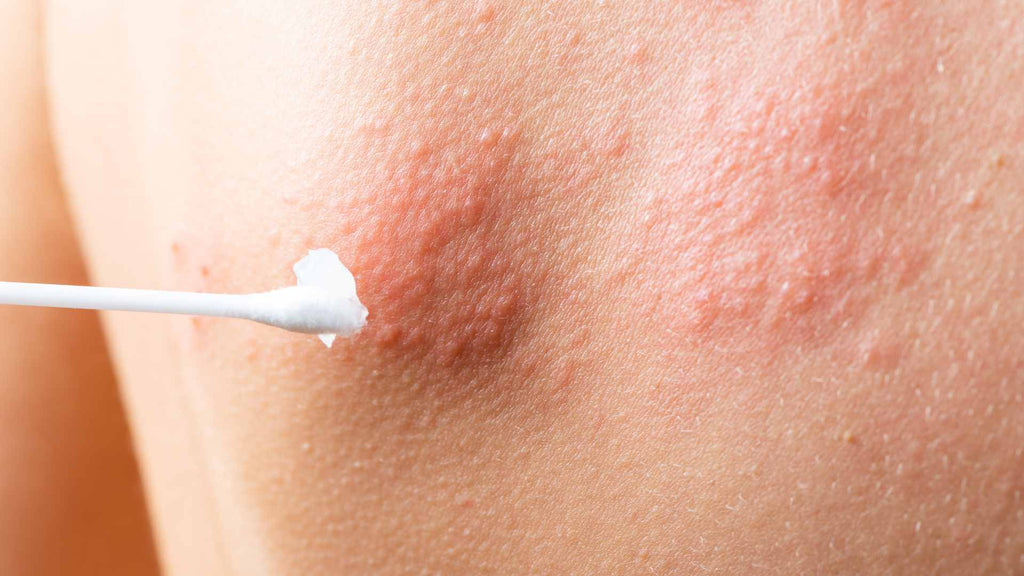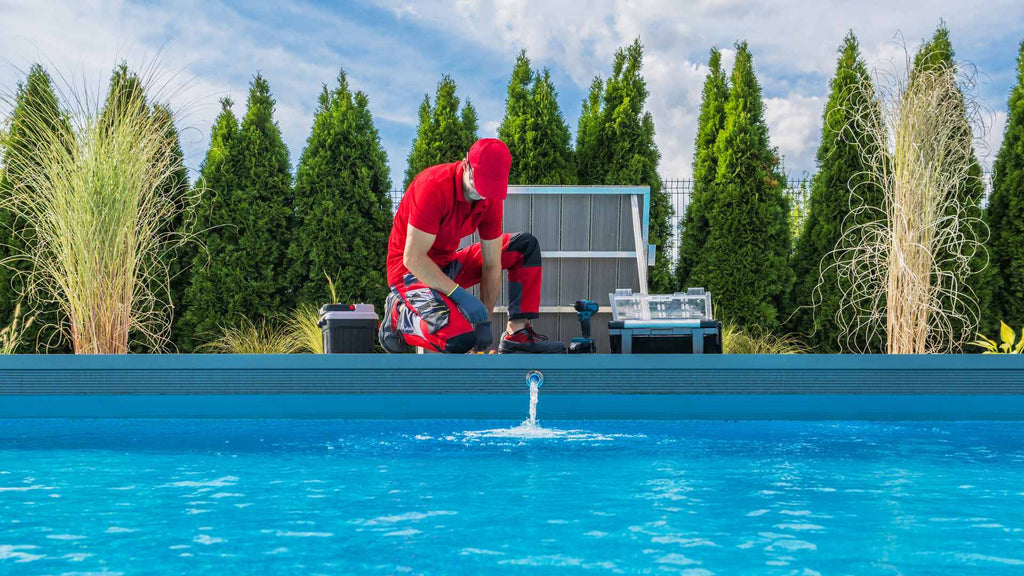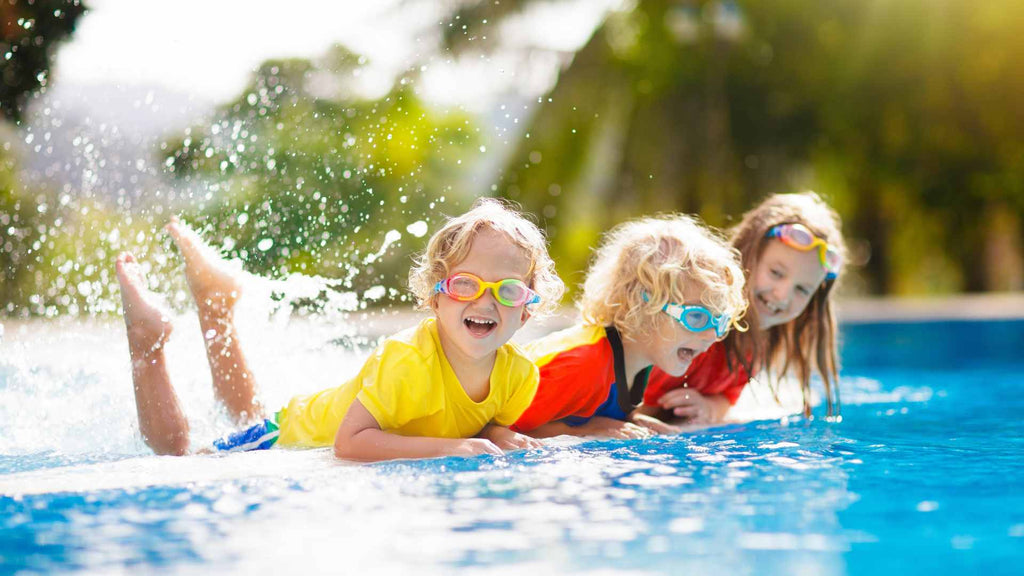Key Highlights
- A chlorine rash is a non-allergic skin reaction that occurs when the skin's protective outer layer is damaged by exposure to chlorine in pools or hot tubs.
- Symptoms of a chlorine rash include skin redness, swelling, itchiness, and the appearance of rash or patch-like lesions.
- Chlorine rash is not contagious and the symptoms usually improve within a few days with proper treatment and avoiding further chlorine exposure.
Immediate actions for chlorine rash relief include rinsing off, applying hydrocortisone cream and gentle moisturizer, and using clean water for cleansing.
- Long-term treatment strategies for chlorine rash involve avoiding chlorine exposure, taking precautions for skin care before and after swimming, and adjusting pool chemical levels.
- Alternatives to chlorine in pools, such as natural pool cleaning methods and technological innovations, offer a safer approach for individuals with chlorine sensitivity.
Introduction
Swimming in a pool is a popular activity during the summer months, providing a refreshing escape from the heat. However, for some individuals, this enjoyable experience may be marred by the development of a chlorine rash. A chlorine rash is a non-allergic skin reaction that occurs when the skin's protective outer layer is damaged by exposure to chlorine in pools or hot tubs. While some people may mistakenly refer to it as a "chlorine allergy," it is actually a form of irritant contact dermatitis. This means that it is not caused by an allergic reaction, but rather by the irritant effect of chlorine on the skin.

Understanding the causes and symptoms of a chlorine rash is important for effectively managing and preventing this condition. By taking immediate actions for relief and implementing long-term treatment strategies, individuals can enjoy swimming without the discomfort of a chlorine rash. Additionally, exploring alternatives to chlorine in pools can provide a safer approach for individuals with chlorine sensitivity.
In this blog, we'll get into the causes, symptoms, treatment, prevention, and long-term strategies for managing a chlorine rash. We will also discuss the science behind chlorine and its impact on different skin types, as well as explore alternative pool cleaning methods and technological innovations.
So, let's dive in and learn more about chlorine rashes and how to prevent and treat them effectively!
Understanding Chlorine Rash: Causes and Symptoms
Chlorine rash, a type of irritant contact dermatitis, typically arises from extended exposure to chlorinated water commonly found in swimming pools. People with chlorine sensitivity may exhibit symptoms akin to a chemical burn, such as redness and itchiness on the skin. This reaction can present as skin redness, bumps, hives, and in severe instances, lesions. Individuals with pre-existing skin conditions like eczema or psoriasis are particularly susceptible to developing a chlorine rash due to the heightened sensitivity of their skin. Recognizing these symptoms early on is essential for prompt intervention and alleviation of discomfort.

It's important to note that your body isn't allergic to chlorine, though you may have a sensitivity and negative reaction to it.
To prevent chlorine rash, individuals can take precautions such as showering before and after swimming to remove any residual chlorine, wearing protective gear like rash guards, and applying moisturizers to create a barrier on the skin. In cases where symptoms persist or worsen, seeking medical advice from a dermatologist is recommended to receive appropriate treatment and care.
Why Chlorine Causes Skin Reactions
Chlorine causes skin reactions because it disrupts the skin's natural barrier, leading to irritation. For individuals with chlorine sensitivity or allergy, this reaction can be more pronounced. The chemical properties of chlorine can strip the skin of its protective oils, causing dryness and redness. Additionally, prolonged exposure to chlorinated water in pools can exacerbate these symptoms. Understanding the specific triggers for each skin type can help manage and minimize the risk of chlorine-related skin issues.
Identifying Chlorine Rash: Common Symptoms and Appearance

Redness, itchiness, and skin irritation are common chlorine rash symptoms. The affected area may develop bumps, hives, or even lesions. In some cases, individuals may experience inflammation or asthma exacerbation, especially if they have underlying skin conditions like eczema or psoriasis. Lifeguards, maintenance workers, and active swimmers are at higher risk due to increased chlorine exposure. Recognizing these signs promptly is crucial for seeking appropriate treatment and preventing further discomfort.
The Difference Between Chlorine Rash and Swimmer's Itch
While both chlorine rash and swimmer's itch involve swimming and itching, they are not the same thing. Chlorine rash occurs due to prolonged exposure to chlorine in swimming pools. It is often confused with swimmer’s itch, which is caused by parasites found in freshwater and saltwater bodies.
However, swimmer’s itch occurs when parasites released from snails infect the water where people are swimming. Properly maintained pools with adequate levels of chlorine are unlikely to harbor these parasites, reducing the risk of developing swimmer's itch.
Immediate Actions to Take for Chlorine Rash Relief
To alleviate a chlorine rash promptly, rinse off in clean water immediately after leaving the pool. Avoid harsh soaps and opt for a gentle body wash. Apply a soothing moisturizer like petroleum jelly or natural oils to lock in moisture. If itching persists, hydrocortisone cream can provide relief, though the directions must b followed very carefully to avoid dangerous side effects.
Refrain from scratching to prevent further skin irritation. Ensure your swimsuit is washed thoroughly to remove any lingering chlorine. Embracing these immediate actions can aid in soothing the discomfort of a rash.
First Aid Measures for Chlorine Rash
For immediate relief from a chlorine rash, start by rinsing off in a shower to remove any remaining chlorine on the skin. Avoid hot water as it can worsen irritation. Apply a gentle moisturizer or hydrocortisone cream to soothe the affected areas. Consider using a petroleum jelly like Vaseline or Aquaphor to create a protective barrier. If the itching persists, taking an antihistamine like Benadryl can help alleviate symptoms. Keeping the skin hydrated with regular application of lotion is crucial in aiding the healing process.

Dermeleve® Bring The Itch Relief
Dermeleve® plays a crucial role in alleviating the persistent itchiness associated with chlorine rash. This specially formulated cream provides relief by soothing the skin and reducing inflammation caused by chlorine sensitivity. Its gentle yet effective ingredients work to calm irritations, making it a go-to solution for those experiencing discomfort after exposure to chlorinated water. Embracing Dermeleve® as part of your skincare regimen can significantly improve your post-swim experience, offering much-needed comfort and relief from skin irritations.
Long-Term Treatment Strategies for Chlorine Rash
For long-term treatment strategies for chlorine rash, it's crucial to address any underlying skin conditions that may exacerbate the rash. Dermatologists recommend avoiding harsh chemicals and opting for gentle moisturizers to soothe irritated skin. Regular use of hypoallergenic body wash and moisturizers can help maintain skin hydration and prevent flare-ups. Additionally, consult a healthcare professional if symptoms persist or worsen over time to explore alternative treatment options tailored to your specific needs.
When to Seek Medical Help for Persistent Symptoms
It is crucial to seek medical assistance if you notice persistent symptoms despite home remedies. If the rash worsens or does not improve within a few days, consulting a dermatologist is recommended. Additionally, if you experience severe allergic reactions such as difficulty breathing, swelling, or widespread rash, seek immediate medical help. Prompt medical attention is essential for proper diagnosis and treatment, especially if you have an underlying skin condition exacerbating the rash. Your health and well-being should always be a top priority.
The Risks of Long Term Topical Steroid Use
Prolonged use of topical steroids for treating chlorine rash poses risks despite offering relief initially. Continuous application may lead to thinning of the skin, discoloration, and increased skin sensitivity. Over time, it can potentially suppress the body's natural cortisol production, leading to adrenal insufficiency. Moreover, long-term use may exacerbate existing skin conditions and cause systemic side effects. It is crucial to consult a healthcare provider before relying on topical steroids for an extended duration to manage chlorine rash effectively.
Dermeleve® As A Safer Alternative
Dermeleve® offers a safer alternative to hydrocortisone cream for treating chlorine rash. Its gentle formulation soothes skin without harsh chemicals, making it suitable for sensitive skin. Unlike traditional remedies, Dermeleve® provides relief without the risk of long-term side effects from steroid use. This natural-based solution helps restore skin health while minimizing the chances of irritation or allergic reactions, ensuring comfort and relief for those struggling with chlorine-induced skin issues.
Preventing Chlorine Rash: Effective Strategies for Swimmers
Effective strategies for preventing chlorine rash in swimmers involve crucial steps. Prior to swimming, applying a barrier cream can shield the skin. After swimming, promptly showering and using a gentle moisturizer aids in washing off chlorine. Wearing swim gear with less exposed skin can minimize contact. Additionally, ensuring proper pool maintenance to regulate chlorine levels is key.

These proactive measures can significantly reduce the risk of developing chlorine-related skin irritations, promoting a healthier swimming experience.
Importance of Pre and Post Swimming Skin Care
To ensure skin health, implementing appropriate pre and post swimming skin care routines is crucial. Before swimming, apply a barrier cream containing zinc oxide to protect your skin. Post-swim, promptly wash off chlorine residue with a gentle body wash. Moisturize generously using a hydrating lotion to replenish lost moisture and maintain skin integrity. These practices aid in safeguarding your skin against the harsh effects of chlorinated water, promoting overall skin health and reducing the likelihood of developing a chlorine rash.
Adjusting Pool Chemicals to Minimize Risk
To minimize the risk of developing a chlorine rash, it's crucial to adjust pool chemicals accurately. Maintaining proper chlorine levels and pH balance in the water can reduce skin irritation. Regularly testing the water quality and following recommended guidelines for chemical concentrations help create a safer swimming environment.
Additionally, ensuring adequate water circulation and filtration can help prevent the buildup of chloramines, which are known to cause skin reactions. Proper chemical adjustment is key to promoting a healthy and comfortable swimming experience.
The Science Behind Chlorine and Skin Health
Chlorine, a common element in chlorinated pools, can adversely affect skin health. For individuals with chlorine sensitivity, exposure can trigger allergic reactions such as irritant contact dermatitis. Chlorine interacts with the skin's natural oils, leading to dryness and irritation, particularly for those with sensitive skin or underlying conditions like eczema or psoriasis. Understanding how chlorine disrupts the skin barrier is crucial in managing its impact on swimmers and pool maintenance workers, necessitating tailored skincare approaches.
How Chlorine Affects Different Skin Types
Chlorine affects different skin types in varied ways due to individual sensitivities and conditions. For those with sensitive skin, exposure can exacerbate issues like eczema or psoriasis, causing increased dryness and irritation. Individuals with allergies may experience more pronounced reactions, leading to redness, itching, or even hives. It is crucial to understand how your skin reacts to chlorinated water to adopt suitable skincare routines and products that replenish moisture and protect against potential irritation.
Chlorine’s Impact on Eczema and Psoriasis
Chlorine's impact on eczema and psoriasis can exacerbate these conditions due to the skin's sensitivity. Individuals with eczema or psoriasis may experience increased dryness, irritation, and inflammation when exposed to chlorinated water. The harsh effects can further trigger flare-ups and worsen existing symptoms. Proper skincare measures, such as post-swimming showers and moisturizing with gentle products, become crucial for managing these skin conditions in chlorinated pool settings. Consulting with a dermatologist for personalized advice on coping strategies is advisable.
Alternatives to Chlorine in Pools: A Safer Approach
When considering alternatives to chlorine in pools for a safer approach, options like saltwater pools or UV light systems provide effective disinfection without harsh chemicals. Saltwater pools use a chlorinator that converts salt into chlorine, reducing skin irritation. UV light systems destroy bacteria and viruses in water, excluding the need for chemical sanitizers. These alternatives offer a gentler swimming experience, particularly beneficial for individuals with chlorine sensitivity or skin conditions exacerbated by chlorinated water.
Natural Pool Cleaning Methods
When considering natural pool cleaning methods, options like using UV light or saltwater systems can be effective in reducing chlorine dependence. UV light systems help break down contaminants in the water without the need for excessive chemicals. Saltwater pools use electrolysis to produce chlorine from salt, providing a gentler alternative. These methods can be beneficial for individuals with chlorine sensitivity or those seeking eco-friendly solutions. Implementing natural pool cleaning methods can contribute to a healthier swimming environment while minimizing potential skin irritations.
Technological Innovations in Pool Sanitation
Advancements in pool sanitation technology have led to safer and more efficient methods of maintaining clean water. Technologies such as ultraviolet (UV) sanitation, ozonation, and saltwater systems offer alternatives to traditional chlorinated pools. These modern approaches reduce chlorine exposure risks and provide a more environmentally friendly option for pool sanitation. By incorporating these innovative technologies, pool owners can enhance water quality while minimizing the potential for skin irritations and allergic reactions associated with chlorine exposure.

Conclusion
Chlorine rash can be an uncomfortable experience for swimmers. Understanding the causes, symptoms, and immediate relief measures is crucial. Dermeleve® offers effective itch relief for immediate comfort. Long-term strategies focus on preventing and managing chlorine rash to ensure skin health. By adjusting pool chemicals and practicing proper skin care, swimmers can minimize the risk of developing a chlorine rash. Exploring alternatives to chlorine in pools presents a safer approach for sensitive skin. Remember, swimmers should prioritize skin care to enjoy a safe and refreshing pool experience. If persistent symptoms occur, seeking medical advice is advisable for proper treatment and care.
Frequently Asked Questions
Should I take Benadryl for chlorine rash?
It is advisable to consult with a healthcare professional before taking Benadryl or any other medication for a chlorine rash. They can provide guidance on the best course of action based on your individual circumstances, including the severity of the rash and any existing medical conditions or allergies you may have. It's always better to err on the side of caution and seek professional medical advice for proper treatment.
Can chlorine rash spread to other parts of the body?
Chlorine rash can spread to other body parts through contact or by scratching. The irritant can cause redness, itching, and discomfort on the skin and may extend to adjacent areas. Proper care and avoiding scratching can help prevent spreading.
How long does it usually take for a chlorine rash to heal?
Chlorine rash typically heals within a few days to a couple of weeks, depending on the severity. Proper skin care, avoiding further exposure to irritants, and using soothing treatments can help speed up the healing process.
Are children more susceptible to chlorine rash than adults?
Children's skin is generally more sensitive, making them more prone to chlorine rashes than adults. Their thinner skin barrier and higher surface area-to-body weight ratio can increase absorption of irritants.
Can I go swimming with chlorine rash if I use Dermeleve®?
Chlorine rash sufferers can swim using Dermeleve®, a product that offers itch relief. It is advisable to seek medical advice before swimming with a chlorine rash, even when using Dermeleve® for symptom management. With caution and proper care, enjoying the pool is possible.
How can I tell if my pool’s chlorine levels are too high?
Look out for strong chemical odors, skin irritation, and cloudy water, indicating high chlorine levels in your pool. Use test strips or kits to measure chlorine levels regularly. High levels can lead to skin issues like rashes.
Is it necessary to see a doctor for every case of chlorine rash?
Seeking medical advice for severe or persistent chlorine rashes is crucial. While most cases can be managed at home, consulting a doctor ensures proper diagnosis and treatment, especially if symptoms worsen or do not improve. Early intervention can prevent complications.




